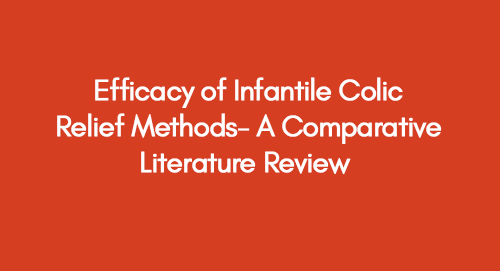
Analytic Study of Pandemic and Financial Crises- A Recommendation for LAFICO
June 3, 2022
Significant Learning Experience in Healthcare
June 3, 2022A comparative literature review underscores the efficacy of manual therapies, such as osteopathy and massage, in providing non-invasive relief for infantile colic. The findings emphasize the importance of a holistic approach to address the diverse nature of this common infant condition. Infantile colic, a distressing condition marked by prolonged periods of excessive crying and fussiness in otherwise healthy infants, poses a significant challenge for parents and caregivers. Despite its prevalence, the precise cause of colic continues to elude medical experts, leading many families to seek solace in traditional methods that have withstood the test of time. Passed down through generations, these age-old remedies offer hope for those grappling with the perplexing nature of infantile colic.
Childhood Care and Development
This blog seeks to delve into the efficacy of these time-tested remedies, examining their historical roots and exploring the scientific evidence supporting their use. By shedding light on the various traditional approaches to relieving infantile colic, we aim to empower parents with a comprehensive understanding of these remedies, helping them navigate this challenging phase of early parenthood with greater confidence and insight.
Introduction
This literature review explores the traditional methods of relieving Infantile Colic and compares them with manual treatments. The analysis is based on a comprehensive synthesis of published research, dividing the essay into an introduction, central review, and conclusion. A summary table of published articles is utilized to elucidate the review's findings, emphasizing the prevalence of manual therapies in improving the quality of life for parents and infants affected by infantile colic.
Skjeie et al. (2013) describe infantile colic as a distressing condition marked by excessive crying in the early months of a child's life. Despite being a self-limiting condition common among infants, its exact aetiology remains undiscovered, often contributing to a distressing cycle of infant crying.
Mothers, to alleviate this condition, employ various methods for Infantile Colic Relief. However, limited evidence supports using complementary and alternative treatments or understanding behavioural intentions related to these approaches. Various strategies exist for addressing this disorder, including probiotics as a conventional method and manual therapy as a highly recommended option, encompassing chiropractic, massage, and osteopathy (Sheidaei, 2016).
According to Steel (2011), osteopathy is a globally practised medical care system with the primary goal of integrating osteopathic manual practices into the medical interventions recommended by healthcare professionals. This literature review aims to shed light on the efficacy of these manual therapies in alleviating infantile colic, providing valuable insights into their application and potential benefits.
Background
Infantile colic, characterized by prolonged and excessive crying in infants during the first few weeks of life, typically resolves spontaneously within two to five months. Excessive crying lasts more than 3 hours daily or occurs more than three days weekly. Gutiérrez-Castrellón et al. (2017) associated infantile colic with factors like intestinal contractions, gas in the gut, lactose intolerance, and potential misinterpretation of normal paternal care. However, recent perspectives suggest both medical and behavioural causes.
Medical hypotheses propose factors such as food hypersensitivity or allergies as contributors to severe infant issues. Seeking relief for infantile colic, many parents turn to medical professionals or explore alternative remedies. Posadzki, Lee, and Ernst (2013) found that manual therapies like massage, osteopathy, and chiropractic methods may be more effective than traditional approaches.
Study Rationale
The chosen topic addresses existing research gaps related to the effectiveness of manual therapies compared to traditional methods in treating infantile colic. Current research has not yielded conclusive findings on the superiority of manual therapies, as indicated by the survey conducted by Bronfort et al. (2010). Despite the global use of diverse strategies for managing infantile colic, the efficacy of each intervention remains uncertain and a subject of debate.
In European countries, treatments like spinal manipulation and simethicone have demonstrated effectiveness in reducing infantile crying. However, conflicting opinions persist regarding the overall efficacy of these treatments. Given the lack of conclusive evidence, the study focuses on shedding light on effective treatments for infantile colic, exploring both traditional methods and manual therapies.
One study suggests that herbal supplements are sufficient for preventing stomach aches in infants, while another proposes acupuncture as an effective means of reducing pain associated with infantile colic. In the context of this discussion, the study undertakes a comprehensive review of various articles on infantile colic therapies, including case studies, to assess the effectiveness of both traditional and manual treatments.
Statement of Research Question
What is the comparison in effectiveness between traditional methods and manual treatment for relieving infantile colic?
Literature Review
In the rich tapestry of scholarly exploration, the literature review unfolds as an intellectual journey through the collective wisdom of past studies and academic discourse. It serves as the compass guiding researchers through the uncharted territories of existing knowledge, allowing them to identify gaps, patterns, and insights that shape the context of their investigation. As a mosaic of diverse perspectives, the literature review weaves together existing research threads, offering a panoramic view that informs, critiques and propels the current study into the ever-evolving landscape of academic inquiry.
Study Evaluation
In Hayden's (2009) study, titled "A preliminary assessment of the impact of cranial osteopathy for the relief of infantile colic," 28 infants suffering from colic underwent osteopathic manipulation. Parents observed their children's crying and sleeping patterns. Results indicated a significant reduction in crying and improved sleep in the fourth week compared to the first week. Infants receiving osteopathic treatment required less parental attention, suggesting its benefits for infantile colic relief.
Sheidaei (2016) investigated the effectiveness of massage therapy in infantile colic symptoms. The study included 100 infants randomly assigned to massage or rocking groups. Massage therapy, administered for 15-20 minutes, showed higher efficacy in reducing colic symptoms than rocking. The one-week intervention significantly improved colic symptoms, highlighting the effectiveness of massage therapy over rocking.
Castejón-Castejón's (2019) study focused on craniosacral therapy (CST) effectiveness for infantile colic, involving 58 infants. Collected four times a day and supported by a colic severity questionnaire, observations revealed a statistical difference between the CST and the control groups' crying hours, sleep hours, and colic severity. The findings suggested CST is a safe and effective option for reducing colic symptoms.
Miller, Newell, and Bolton's (2012) study aimed to determine the efficacy of manual chiropractic therapy for infants with unexplained crying behaviour. One hundred and four patients were randomized into three groups. The study concluded that chiropractic manual therapy improved crying behaviour among infants with colic, and parental awareness of treatment did not influence its effectiveness.
Salvatore's (2016) article explored pharmacological interventions for early functional gastrointestinal disorders. While emphasizing the multifactorial nature of functional gastrointestinal disorders, the study found the essential role of pharmacological intervention in rectal disimpaction for childhood constipation. Still, it did not support pharmacological therapy for the specific disease under consideration.
Holm's (2018) study focused on the effects of chiropractic treatment for infantile colic using a single-blind randomized control trial. The study involved families with infants aged 2-14 weeks attending a chiropractor clinic. After four visits, positive results were observed, indicating reduced crying due to infantile colic. The study suggested chiropractic treatment as a potentially effective intervention for infantile colic relief.
Summary of Findings
Analyzing Hayden's (2009) findings reveals that infants who underwent osteopathic treatment for infantile colic required less parental attention. This observation led the researcher to conclude that osteopathic treatment holds benefits for addressing colic in infants. Additionally, Sheidaei's (2016) study, based on secondary research, highlighted the clinical effectiveness of massage therapy in alleviating colic symptoms. The comparison with rocking indicated that massage therapy is more beneficial in treating colic symptoms.
In the case of Castejón-Castejón (2019), the study's outcomes suggested that craniosacral therapy is a more effective and beneficial approach for treating infantile colic. The research demonstrated that craniosacral therapy reduces crying hours and colic severity, increasing total sleep hours.
The research conducted by Miller, Newell, and Bolton (2012), involving 104 infants, found that chiropractic manual therapy was instrumental in improving the crying behaviour of infants experiencing colic. Notably, the study indicated that parental awareness of the treatment did not impact its effectiveness.
Salvatore's (2016) exploration of pharmacological interventions emphasized the essential role of pharmacological treatment in rectal disimpaction for childhood constipation. However, the study did not support the efficacy of pharmacological therapy for treating other diseases.
Holm's (2018) study delved into the effects of chiropractic treatment for infantile colic, suggesting that chiropractic is a commonly used method. Despite this, the study acknowledged limited evidence supporting its effectiveness.
Significance of Findings
Upon critically reviewing and evaluating the articles, several key aspects emerge. The principles underlying osteopathic manual practices emphasize maintaining a holistic perspective when treating patients, whether pediatric, pregnant or from any other category. The foundational concept is that the entire body functions as a unified unit, and any proposed treatment should avoid causing stagnation. In contrast, chiropractic manual therapy, as applied in Miller's research (2012), addresses issues such as repetitive crying and discomfort in infants, particularly focusing on conditions like infantile colic.
Hayden's study (2009) employs a controlled and open approach within a selected sample group of patients, specifically 28 infants diagnosed with colic. This methodology ensures a thorough examination of the impact of osteopathic treatment on infantile colic, as documented by Steel (2017).
Sheidaei's study (2016) introduces a training model where infants with colic undergo treatment, either through massage therapy or in various areas. The research suggests that infants who receive regular massages experience quicker improvements in their well-being. Similarly, Castejón's study (2019) indicates that minors treated with chiropractic manual therapy show enhanced well-being and relief from infantile colic.
Infantile colic, characterized by uncontrolled crying in infants, presents challenges for parents, causing distress and anxiety. Doctors have recommended conventional approaches, but alternative clinical interventions and manual techniques prove more effective in managing the situation, as highlighted in the study by Miller, Newell, and Bolton (2012).
The research design, particularly the Randomized Control Trial (RCT) adopted by Miller, Newell, and Bolton (2012), stands out for evaluating the effectiveness of chiropractic treatment for infantile colic. The study contributes to filling gaps in the literature, exploring the potential benefits of intervention for specific subgroups of children with suspected problems, and ultimately aiming for improved outcomes.
Quality Criteria Of Chosen Articles
The assessment of the chosen articles involved a rigorous evaluation using the Risk of Bias (ROB) tool from the Cochrane Collaboration. Each domain within the tool, including sequence generation, blinding of participants and research personnel, handling of incomplete data, and potential biases, was carefully examined and graded as High Risk (H), Unclear (U), or Low Risk (L). Additionally, the articles considered the selective reporting procedures, where study protocols were identified and rated as Low Risk (L) if no disparities were found between the reported results and the initial protocol.
To account for the diverse outcomes expected in the studies, an assessment involved estimating the Risk Ratio (RR) for dichotomous continuous outcomes. In cases where clinical and statistical heterogeneity was observed, a thorough review of different studies was conducted to reassess findings and scrutinize the data collection methodology. This comprehensive evaluation aimed to ensure the robustness and reliability of the selected articles in contributing to the overall understanding of the respective topics.
The Relevance of the Research
This study references six distinct research endeavours centred on exploring effective treatments for addressing infantile colic. Its significance extends to various stakeholders, particularly patients and the public. The researcher aims to disseminate valuable information to patients and the general public, emphasizing the potential benefits of osteopathy and massage for infantile colic treatments. The study introduces novel solutions with a specific focus on the role of osteopathy in this context.
Significant Learning Experience in Healthcare
An essential aspect of the study is its effort to provide empirical evidence supporting the effectiveness of osteopathy in treating infantile colic. Doing so advocates for the valuable contribution that osteopaths, serving as manual therapists, can make in this field.
The study is a comprehensive resource highlighting the positive outcomes achievable through therapy and massage treatments for infantile colic, especially relevant for healthcare communities. It underscores the potential advantages of embracing non-pharmacological interventions, such as osteopathy and related massage therapies, in the overall treatment approach for infantile colic.
The study encourages healthcare communities to foster a culture that recognizes and promotes osteopathic and massage treatments as viable options for managing and alleviating infantile colic.
Review the following:
Conclusion
In summary, osteopathy, characterized by non-aggressive manual practices conducted through hands-on techniques, emerged as a focal point in the study, particularly in its application to infantile colic. While certain medications provide partial relief for colic, the study delved into the therapeutic impact of osteopathy, including manual techniques like massage, on addressing this disorder. The findings suggest that manual therapy, encompassing osteopathic approaches, proves highly effective in treating infants with colic. Multiple studies underscore the significance of osteopathic interventions and treatment techniques in achieving positive outcomes for colic in infants. The research focuses on the importance of various massage techniques and other osteopathic treatments in managing and alleviating infantile colic.
References
Bronfort, G., Haas, M., Evans, R., Leininger, B. and Triano, J., 2010. Effectiveness of manual therapies: the UK evidence report. Chiropractic & osteopathy, 18(1), p.3.
Castejón-Castejón, M., Murcia-González, M.A., Gil, J.M., Todri, J., Rancel, M.S., Lena, O. and Chillón-Martínez, R., 2019. Effectiveness of craniosacral therapy in the treatment of infantile colic. A randomized controlled trial. Complementary therapies in medicine, 47, p.102164.
Gutiérrez-Castrellón, P., Indrio, F., Bolio-Galvis, A., Jiménez-Gutiérrez, C., Jimenez-Escobar, I. and López-Velázquez, G., 2017. Efficacy of Lactobacillus reuteri DSM 17938 for infantile colic: Systematic review with network meta-analysis. Medicine, 96(51).
Hayden, C. and Mullinger, B., 2009. Reprint of: A preliminary assessment of the impact of cranial osteopathy on the relief of infantile colic. Complementary therapies in clinical practice, 15(4), pp.198-203.
Holm, L.V., Jarbøl, D.E., Christensen, H.W., Søndergaard, J. and Hestbæk, L., 2018. The effect of chiropractic treatment on infantile colic: study protocol for a single-blind randomized controlled trial. Chiropractic & manual therapies, 26(1), p.17.
Miller, J.E., Newell, D. and Bolton, J.E., 2012. The efficacy of chiropractic manual therapy on infant colic is a pragmatic single-blind, randomized controlled trial. Journal of Manipulative and Physiological Therapeutics, 35(8), pp.600-607.
Posadzki, P., Lee, M.S. and Ernst, E., 2013. Osteopathic manipulative treatment for pediatric conditions: a systematic review. Paediatrics, 132(1), pp.140-152.
Salvatore, S., Barberi, S., Borrelli, O., Castellazzi, A., Di Mauro, D., Di Mauro, G., Doria, M., Francavilla, R., Landi, M., Martelli, A. and Miniello, V.L., 2016. Pharmacological interventions on early functional gastrointestinal disorders. Italian Journal of Pediatrics, 42(1), p.68.
Sheidaei, A., Abadi, A., Zaveri, F., Nahidi, F., Gazerani, N., and Mansouri, A., 2016. The effectiveness of massage therapy in treating infantile colic symptoms: A randomized controlled trial. Medical journal of the Islamic Republic of Iran, 30, p.351.
Skjeie, H., Skonnord, T., Fetveit, A. and Brekke, M., 2013. Acupuncture for infantile colic: a blinding-validated, randomized controlled multicentre trial in general practice. Scandinavian Journal of Primary Health Care, 31(4), pp.190-196.
Appendices
Study | Objective | Methodology | Finding | Conclusion |
Castejón-Castejón (2019) | To evaluate the efficiency of ACT in treating infantile colic | Episodic check-up for progress after implying CST sessions every week for 24 days. There is a randomized trial in which 58 infants are involved that are between 0 to 84 days and are diagnosed with infantile colic. Every baby in a week has a 30 to 40 CST session. The babies in the CST group have received 1 to 3 sessions in 14 days. The data has been collected 4 times a day. | The sleep hours and crying hours are improved in a controlled group. The results of ANCOVA and the baseline crying, regarded as the covariate, demonstrate the important group affecting the crying hours. The CST group shows improvement in every endpoint. | The CST approach is safe and effective for infantile colic. It reduces the number of hours they spend crying and the severity of their colics and increases their total sleep hours. |
Hayden (2009) | To distinguish the impact of cranial osteopathy in treating infantile colic | Parents were asked to care for and rock their babies before sleep during the sessional therapeutic routine of cranial osteopathy for four weeks. This study involved 28 randomised infants for cranial osteopathic manipulation or getting no treatment in 4 weeks. The treatment is as per the findings of individuals administrated by a similar practitioner. The parents were asked to record the time babies cried, slept, and were held daily. | Sleep time increased, and crying time decreased. There is an overall decline in crying, nearly 63% and 23% for the treated and controlled groups, respectively. There is an improvement in sleeping, about 11% and 2%. Infants that are treated need less attention from their parents than untreated patients. | It is observed that cranial osteopathy is an effective approach to treating colic. Through this, the infants can relax, cry less, and sleep for a long time. |
Holm (2018) | To evaluate the outcome of chiropractic treatment in curing infantile colic | Selected children were exposed to chiropractic treatment twice weekly, and the results were monitored accordingly. The study is mainly designed to be single-blind, randomized, and controlled. The respondents are families living on the Island of Funen, and information regarding the project is mainly from the health visitors and maternity wards. The children who are at the age of 2 to 14 weeks who have unexplained excessive crying are screened for eligibility. | Parents reported better sleeping patterns and reduced crying episodes after the sessions. The main thing evaluated in the single-blind randomized controlled design is that the effectiveness of the treatment depends on chiropractic treatment of infant colic. This study's main contribution is to determine the effect of this treatment on infantile colic in areas with limited evidence. | My health was improved, and the stress was relieved. Infantile colic is considered the condition which is usually faced during childhood and affects almost one infant out of six infants. This condition is characterized by crying, which is not consolable, and fussing, which otherwise results in healthy and thriving infants. |
Miller (2012) | The study aims to distinguish the proficiency of the Chiropractic Manual Therapy in treating infant colic through RTC. The objective of the study is to cure the conditions of repetitive crying and other discomforts of babies like infantile colic. | Children were divided into three subgroups and were given the Chiropractic Manual Therapy sessions. Followed by monitoring. For this study, infants with unexplained persistent crying problems are included at the chiropractic teaching clinic in the UK. Infants of 8 weeks are involved in the study. | The crying time was reduced. Three children are treated, whereas some infants are under treatment. | It is an effective approach to curing the infant colic |
Salvatore (2016) | To present a pharmacological approach to dealing with Functional gastrointestinal disorders (FGIDs) in infancy and early childhood. | The research is based on evaluating secondary data from electronic records and databases. The relevant literature was also reviewed. | No definite evidence was found in the explanation of therapeutic approaches to deal with Functional gastrointestinal disorders (FGIDs) | Some medicines are suggested to cure Functional gastrointestinal disorders (FGIDs), but the results depend on the cases, respectively. |
Sheidaei (2016) | An RCT approach was used to evaluate the proficiency of massage therapy in curing infant colic. | The massage was given to the selected colic infants for about twenty minutes, and the RCT group was rocked gently for the observed same interval, roughly before sleep time. | The massage therapy resulted in ease of sleep and a decrease in crying time. | Massage therapy shows the best results in treating colic infants in the domain of manual therapies. |
Steel (2017) | The research is dedicated to analyzing the role of osteopathy in manual treatments of medical complications. | The structure of the study includes the evaluation of the performance of healthcare players in the field of providing medical assistance to the public. | The research has declared that the conduct of mania treatment and osteopathy has been the foremost technique for curing complications in the majority of countries. | Through osteopathy, medical therapeutic interventions have become safer and easier to conduct. It is analyzed that massaging improves people's colic symptoms in one week of intervention for every outcome. Major differences are observed among the intervention and control groups favouring massaging; therefore, this therapy is regarded as effective compared to rocking for infants with colic symptoms. |
Question | Y, N, ? na | Comment |
1. Is the study population clearly defined with inclusion and exclusion criteria? | N | What is the study population? |
2. Is the sample representative of the population? The best samples are taken randomly from the whole population, but sometimes modifications of random sampling are used (these include stratified sampling, cluster sampling, or multistage sampling). Nonrandom sampling techniques may be used but are less representative of the population (e.g. volunteers, purposive sampling, snowball sampling, incidental/convenience sampling, quota sampling, etc). small nonrandom samples are particularly unrepresentative. Are alternatives to random sampling explained and justified? | N | Note how the sample was taken |
Question | Y, N, ? na | Comment |
1. Is the study population clearly defined with inclusion and exclusion criteria? | N | What is the study population? |
2. Is the sample representative of the population? The best samples are taken randomly from the whole population, but sometimes modifications of random sampling are used (these include stratified sampling, cluster sampling, or multistage sampling). Nonrandom sampling techniques may be used but are less representative of the population (e.g. volunteers, purposive sampling, snowball sampling, incidental/convenience sampling, quota sampling, etc). small nonrandom samples are particularly unrepresentative. Are alternatives to random sampling explained and justified? | N | Note how the sample was taken |
3. Is a power calculation performed to determine sample size?
| N |
|
4. Are the sample participants randomly allocated to the intervention and control groups? Random allocation is where those in the selected sample are given an equal chance of being assigned to test groups (either the treatment group or the control). Ensure that the participants' mix for treatment and control is similar (age, gender, ethnicity). This makes the comparison fair. Ensures that when results are compared at the end, differences are due to the intervention, not pre-existing differences in the population.
| N | Outline the method of allocation to groups. |
5. Did the paper use nonparametric or parametric statistics? Parametric Statistics include median, mode, quartiles, inter-quartile range, Wilcoxen test, Mann Whitney U test, Spearman’s Rank Correlation Coefficient, etc. Parametric Statistics include Mean, Standard Deviation, and Confidence. Intervals t-test (paired and unpaired), Pearson’s Correlation Coefficient, etc | N | Note the descriptive statistics used.
Note the inferential statistics used. |
6. Is the choice of statistics appropriate? First, decide if parametric or nonparametric tests should be used. Then, decide which test is appropriate. | N | Comment on the appropriateness |
7. If appropriate, do the researchers justify using unusual statistics? | N |
|
8. Is the null hypothesis clear (either stated or implied)
| N |
|
9. Are there any significant differences between the groups at the beginning of the trial? | N | If there are significant differences, what are they, and how might they have affected the outcomes (i.e. acted as confounding factors)?
|
10. Are all participants who started the study accounted for? Participants withdraw after the start of a trial for various reasons, including adverse reactions, loss of motivation, clinical reasons, personal reasons, etc. Withdrawal can bias the results. Reasons for withdrawal should be recorded. | N | Is there a consort diagram to show participants' flow at each trial stage? If there is no flow diagram, note if the paper records withdrawals (dropouts), nonresponders, etc. Note how many dropouts/nonresponders.
|
11. Is it clear how withdrawals and non-responders were kept to a minimum?
| N |
|
12. Are results analyzed on an ‘intention to treat basis’, i.e. people who start the trial and withdraw are included in the analysis? There is no consensus on analysing an ‘intention to treat basis’, and analyses have different drawbacks.
| N | If appropriate, note the method used for intention to treat analysis. What do you see as the drawbacks of the method used? |
13. Is it clear how outliers were analyzed? | Y |
|
14. Are the data normally distributed? | N | Outline how data were tested for normal distribution by the researchers.
|
15. Are ‘p’ values stated? The lower the p-value, the less likely the difference happened by chance, so the higher the significance of the finding. A p-value of 0.05 and smaller is used to decide if the results are statistically significant and unlikely to have occurred by chance. | N |
|
16. Are the statistics interpreted correctly?
| N |
|
17. Are the limitations of the statistics discussed, e.g. small sample size, dropouts, etc?
Remember, small nonrandom samples may be unrepresentative of the population, so differences between intervention and control groups might not be found in the population. | N |
|
18. Is statistical significance discussed as clinical significance? | N |
|
Get 3+ Free Dissertation Topics within 24 hours?



























